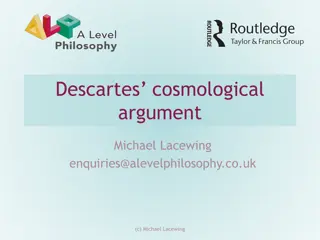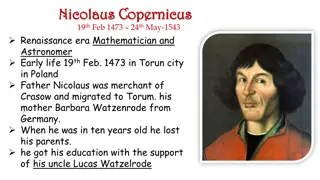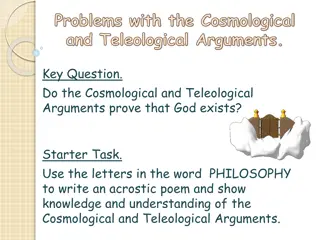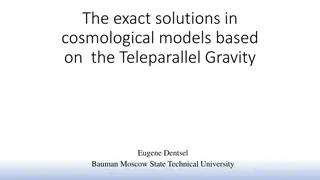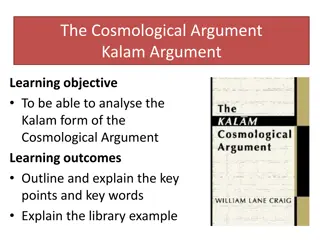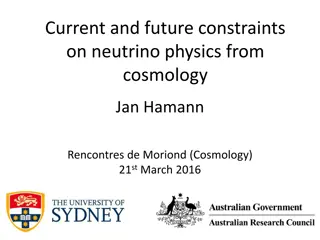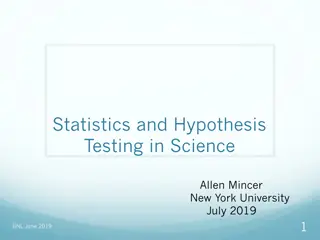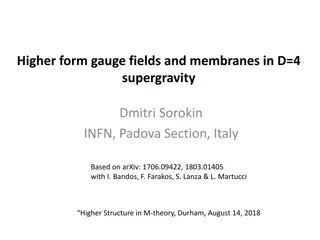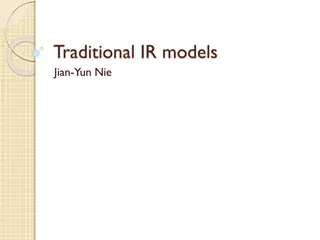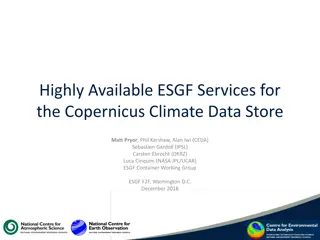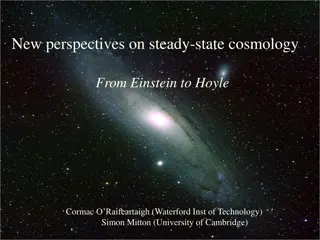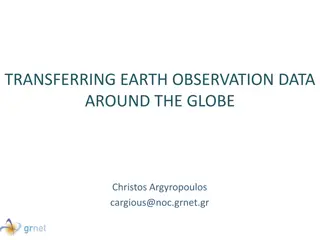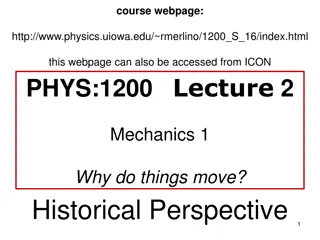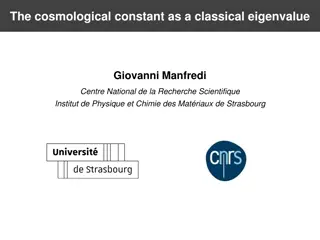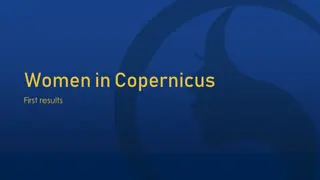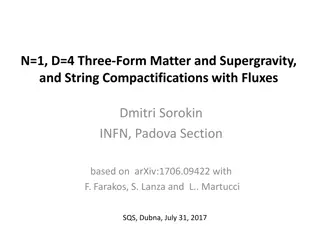The Evolution of Cosmological Models: Tycho vs. Copernicus
Explore the historical debate between Tycho Brahe's Earth-centered universe and Copernicus's heliocentric model, focusing on the impact of worldviews on interpreting evidence, the relationship between physics and cosmology, and the role of mathematical constructs in representing real entities. Discover how Tycho's meticulous observations and improvements in accuracy challenged traditional cosmology, leading to the acceptance of the Copernican system. Delve into discussions on parallax, distinguishing features of each model, and the implications of observational evidence on cosmological paradigms.
Download Presentation

Please find below an Image/Link to download the presentation.
The content on the website is provided AS IS for your information and personal use only. It may not be sold, licensed, or shared on other websites without obtaining consent from the author.If you encounter any issues during the download, it is possible that the publisher has removed the file from their server.
You are allowed to download the files provided on this website for personal or commercial use, subject to the condition that they are used lawfully. All files are the property of their respective owners.
The content on the website is provided AS IS for your information and personal use only. It may not be sold, licensed, or shared on other websites without obtaining consent from the author.
E N D
Presentation Transcript
Tycho Themes for today: The effect of a world view on interpretation of the evidence. The relation between physics and cosmology. Which mathematical constructs stand for real entities? Topics: Tycho's Earth-centered universe Kepler s solution to the problem of the planets. Galileo s overthrow of Aristotle s physics (part 1).
backtrack from Galileo to Tycho Brahe Tycho took systematic observations. Still no telescope, but Improved accuracy (by a factor of 2 to 10) and reliability (no fudging). No more need for ancient data. (important psychologically) As Kuhn puts it: (p. 209) In short, the observations with which Brahe and his contemporaries speeded the downfall of traditional cosmology and the rise of Copernicanism could have been made at any time since remote antiquity. The phenomena and the requisite instruments had been available for two millenniums before Brahe s birth, but the observations were not made or, if made, were not widely interpreted. Since no theory encompasses every possible observation one must decide which phenomena are important or relevant Planetary motion? Copernicus epicycles? But Galileo s new telescopic observations strongly reinforced the Copernican picture. Are there alternatives?
Tycho's System Distance to stars not determined. Tycho s Model The Sun, Moon, and stars still orbit the Earth. Sun The planets orbit the Sun. Orbits around Earth are still westward, but orbits about Sun are eastward. How is Tycho smodel distinguishable from Copernicus ? Earth
Distinctions? Parallax? It is often said that Tycho's model implies the absence of parallax, and that Copernicus' requires parallax. Yet it would not be a major conceptual change for Tycho to have the stars orbit the Sun (like the planets do), which would give the same yearly shifts in their apparent positions as parallax gives. So if parallax were observed, a flexible Tychonean could adjust the theory to account for it, without undue complexity. What if parallax is not observed? For Copernicus, one only needs that the stars be far enough away for the parallax to be too small to see. Therefore the presence or absence of parallax doesn t force the choice of one type of model over the other. If different stars were to show different amounts of parallax, that would rule out the possibility of them all being on one sphere, but still not really decide between Tycho and Copernicus. Would other astronomical features decide?
Copernicus' universe Looking Down at the North Pole (not to scale) Tycho's System Stars are at least 1000 times as far from Sun as is the Earth Distance to stars not determined. Sun Sun Earth Earth
Tycho-Copernicus Distinction? If we don't worry about the distant stars, these two models describe identical relative motions of all the objects in the solar system. So the role of observation is not as direct as you might have guessed. No bare observation can distinguish whether Tycho (taken broadly) or Copernicus (taken broadly) is right. This statement would NOT apply to the Ptolemy/Copernicus dispute. So beware generalizations about how scientific issues are resolved.
Kepler (b. 1571) K started as a firm believer in the heliocentric cosmology with a mystical passion for the Platonic ideal. Described orbital distances from sun in terms of embedded regular solids (which has no significance at all from a modern point of view, but shows a fanatical desire to find mathematical patterns.) K inherited T s data in 1602 and used it to radically simplify the description of the motion of the planets. Kepler s three laws of planetary motion (1609, the same year as G s telescope observations) 1: The orbit of each planet about the Sun is an ellipse with the Sun at one focus of the ellipse. 2: The line joining the Sun and the planet sweeps out equal areas in equal times. 3: The square of the period of one complete orbit is proportional to the cube of the length (major axis) of the ellipse. T2 = k L3 same k for each planet
Perspective K s 3rd law is only meaningful because the Copernican-Tychonean picture allowed the distances to be inferred from the major deviations from simple apparent orbits, because all major deviations were assumed to come from the same source- parallax due to the earth's motion- and not from separate peculiarities of each planet. Kepler's laws were not easy to find! Direct observation gives you only the angle you have to look out from Earth to see a planet, not the distance! It doesn't give you how much of the relative motion is due to the Earth and how much is due to the planet. There is an infinite family of mathematical curves to search among to find ones that will describe the motion. In finding curves, you can adjust both the laws for how fast the planets go around different parts and the laws for how the distances change with time- and both types of changes can give the same changes in apparent positions. The actual orbits are all very close to circles, but with the Sun offset significantly from the center, so the speeds vary significantly over an orbit. One possible route to Kepler's laws is to assume circular motion, but with eccentric orbits and the equal-area law to describe orbital rates. Then converting the eccentric circles to ellipses is a fairly small correction, giving improved fit to the data.
All vestige of circular motion is gone. Refutes one of Aristotle s fundamental physics principles: Let this suffice to prove that no change can be infinite or continuous with the exception of circular motion. (Aristotle, Physics, book Q) a major blow to the long habit of accepting Aristotle's vague arguments as the final word on science. The whole tradition of categorical reasoning was thrown into doubt. These simple laws reproduce the observed motion perfectly , (within the accuracy of Tycho s measurements). Only two numbers are required to describe each planet s motion. For someone who gives mathematical simplicity the highest priority, this proves the validity of the (modified) Copernican system. But one could also make a Tychonean model with elliptical orbits. Question: Is there an observation which would distinguish an elliptical Tychonean model from an elliptical Copernican model?
Copernicus' universe Looking Down at the North Pole (not to scale) Tycho's System Stars are at least 1000 times as far from Sun as is the Earth Distance to stars not determined. Sun Sun Earth Earth
Can we keep Tychos Model? Tycho s model now requires that the Sun s motion about the Earth is described in the same way as the planets motions about the Sun. the period of the Sun's orbit around the Earth is exactly the same as would be the period of the Earth's orbit around the Sun, if the Earth were a planet! And the Earth happens to be about the same size as some other planets. And all the other instances we see have the littler object going around the bigger object. If it orbits like a planet and looks like a planet .. Astronomy is now MUCH simpler if we say the Earth moves like other planets. But if the Earth moves, we need a new physics of motion. So at this point we have a choice: astronomy seems to need the Earth's motion for simplicity, but terrestrial dynamics (per Aristotle) requires that the Earth stand still.
Aristotles physics Aristotle argued that the Earth can t be moving because everything not actually standing on the Earth would seem to move together the opposite way. This argument is based on the assumption that the air, etc. tries to stand still (zero velocity) in some absolute sense. Aristotle describes both a natural motion and a natural position: The natural motion of the Earth and its parts is to the center of the Universe It is not every chance direction which is up, but where fire and what is light are carried ... {Down is] where what has weight and is made of earth are carried. ... These places do not differ merely in relative position, but also as possessing distinct potencies. [I.e. heavy bodies fall toward the center of the Earth not because it is the center of the Earth, but because it is the center of the universe- that's why the Earth is there.] This is the first explicit appearance of a recurrent issue - is there a structure to space, or only to the stuff in it?
Aristotle against Inertia He argued that an arrow in flight was kept in motion by the displaced air rushing in behind the arrow. Question: what evidence comes to mind as to whether the medium sustains the motion?
Metaphysics: Aristotle -> Galileo Aristotle mechanics blended with a sense of purpose. E.g. the gods were immortal, the stars never changed, therefore the gods dwelt in the eternal stars. Both embodied perfection unknown on Earth. Some version of these ideas predated Aristotle and continued into medieval thought. Galileo: a whole new way of looking Believed there is a reality independent of our senses. In fact, our senses often mislead us (e.g., the Earth does move). I cannot sufficiently admire the eminence of those men s [Aristarchus and Copernicus] wits. ... They have been able to prefer that which their reason dictated to them to that which sensible experiments represented most manifestly to the contrary. (Two Great Systems) Performed systematic experiments to determine the behavior of objects. Words alone are not significant. Our disputes are about the sensible world, and not one of paper. (Dialog Concerning the Two Great Systems of the World) The idea of cause is separated from any notion of purpose. Cause is merely the effect one object has on another. Purpose implies a more global interaction (a goal). Huygens and Leibniz were more radical; they spoke of the universe as a machine.
Galileo: Reason and Data Data are not the whole story; math is also needed to organize observation into a coherent whole. One must follow the logic wherever it goes. "Philosophy is written in this grand book, the universe, which stands continually open to our gaze. But the book cannot be understood unless one first learns to comprehend the symbols in which it is composed. It is written in the language of mathematics, and its characters are triangles, circles, and other geometric figures Without these one wanders about in a dark labyrinth." (Il Saggiatore) Once a mathematical picture is formed, you can reason beyond the data: The knowledge of a single fact acquired through a discovery of its causes prepares the mind to understand and ascertain other facts without need of recourse to experiment. (Two New Sciences) Galileo's outlook is still not very popular- especially his dig about wandering in a dark labyrinth if you don t know math. Common myth: Galileo was devoted exclusively to data Common scholarly rejoinder: He was really the last Aristotelian, a believer in formal arguments and perfect forms. What was special about Galileo was his integration of these two approaches.
Galileos observational method He saw the moons of Jupiter, didn t deduce them from theory. The Orthodox Objection to Galileo s moons There are seven windows in the head, two nostrils, two ears, two eyes, and a mouth: so in the heavens there are two favorable stars, two unpropitious, two luminaries, and Mercury alone, undecided and indifferent. From which and many other phenomena of nature such as the seven metals, etc... we gather that the number of planets is necessarily seven. Besides, ...[we] have adopted the division of week into seven days, and have named them for the seven planets; now if we increase the number of planets, this whole system falls to the ground. Moreover the satellites are invisible to the naked eye and therefore can have no influence on the Earth and therefore would be useless and therefore do not exist. Francesco Sizi, Florentine astronomer.
Galileos theoretical method Aristotle claimed that heavier bodies fall faster. So if you tie a 1 lb weight to a 10 pound weight, does the 10 lb weight a) fall faster (now 11 lb) or b) slower (held back by the 1 lb) ? Galileo is really using a deep principle here: The laws of nature must predict the same phenomena regardless of our choice of verbal expression. We will see this principle repeatedly.
Galileos terrestrial physics experiments a series of systematic measurements of the motions of terrestrial objects- not a common practice then. Consider also William Gilbert, 1540-1603 To compare Aristotle and Galileo, let's establish some (modern) terminology: Position: with respect to some origin. Displacement: Velocity: Acceleration:
Physics changes its focus Aristotle says there is an absolute and natural position for each kind of object the choice of origin is not arbitrary. an absolute and natural velocity. Zero for earthlike material Motion requires the continuous application of a force. Acceleration is not discussed per se. The motion of an object is explained by its tendency to return to its natural state. For Galileo there is no absolute or natural position. no natural velocity. The velocity of an object will remain constant in the absence of a force. The accelerations of objects are explained by external forces. The complete explication of the law of inertia is due to Descartes. It is not clear that G understood the problem in 3 dimensions. All of his arguments about inertia take place in two, on the surface of the Earth (no vertical motion). (He failed to use the same principle to argue about the tides.)




